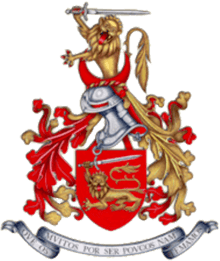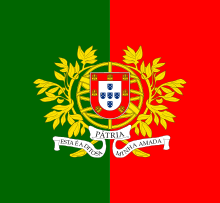Special Operations Troops Centre
The CTOE - Centro de Tropas de Operações Especiais (Special Operations Troops Centre), based in Lamego, is a unit of the Portuguese Army with the mission of instructing troops in unconventional warfare and Counter-Terrorism. Until 2006, it was known as CIOE - Centro de Instrução de Operações Especiais (Special Operations Instruction Centre).
| Portuguese Army Special Operations Troops Centre | |
|---|---|
| Centro de Tropas de Operações Especiais | |
 CTOE Coat of Arms | |
| Active | 1960 – Present |
| Country | |
| Branch | Portuguese Army |
| Type | Special Forces, Unconventional warfare, Hostage rescue |
| Size | Two Companies |
| Part of | Rapid Reaction Brigade |
| Garrison/HQ | Lamego, Portugal |
| Nickname(s) | Rangers |
| Motto(s) | "Que os muitos por ser poucos não temamos" ("The Brave tho' few shall ne'er the Many fear", from The Lusiads, Canto VIII, 36, v. 7) |
| Website | https://www.exercito.pt/pt/recrutamento/tropas-especiais/opera%C3%A7%C3%B5es-especiais |
| Insignia | |
| Identification symbol | Portuguese Army Special Operations Badge.jpg |
| Identification symbol | Special Operations Qualification Badge |
The CTOE contains an operational unit called DOE, its Special Operations Detachment, popularly known as Rangers, tasked with performing missions similar to the US Army's Delta Force or British Special Air Service. Some of these missions include conducting Long-Range Reconnaissance Patrols (LRRP), raids against high-value targets, locating enemy command and control centres, targeting and destruction of enemy air defences and radar systems, and POW rescue operations. The unit can be infiltrated by parachute, helicopter, small boat, or by foot.
History
The CTOE, heir of the historical traditions of Regimento de Infantaria 9 (9th Infantry Regiment), was created on 16 April 1960 to form units specialised in counter-guerrilla operations, psychological operations, and mountaineering. These special, light-infantry units were called Caçadores Especiais (Special Hunters; the regular army light-infantry units were just called Hunters) and were the first units in the Portuguese Army to wear a beret (brown) and camouflage. They were elite units, with highly motivated, hand-picked personnel, whose instructors had taken courses on counter-insurgency and counter-guerrilla operations in France, Algeria, the United States, the United Kingdom, and Spain. When the Portuguese Colonial War began in 1961, there were already four companies of Special Hunters in Angola. Early in the fighting, the Caçadores Especiais received updated 7,62 mm NATO small arms such as the Espingarda m/961 (Heckler & Koch G3) and the FN/German G1 FAL rifle (known as the m/962); the FAL was a favored weapon of the Caçadores Especiais due to its lighter weight and better practical accuracy compared to the m/961 G3. The 4th Company Caçadores Especiais in particular was a very active one (their website contains lots of photos and detailed mission chronology, ). Still, by the end of 1961, the Special Hunters had been disbanded: some of their training was incorporated into the instruction of the regular army Hunter companies, and the brown beret and camouflage spread to the whole Army. The CTOE remained, now tasked with giving their courses to officers and NCOs, and to form commando troops.
After the creation of the special operations unit in 1981, the CTOE ceased to be just an instruction facility but also served as the HQ for the new Portuguese special operations unit. The unit members wear a grass green beret and are the heir of the Special Hunters: the beret badge includes a trumpet — a symbol of the Special Hunters; and the unit is known as Rangers because the first instructors of the Special Hunters completed the Ranger Course and adapted the characteristics of that training to the Special Operations Course. The unit has operated in Bosnia and Herzegovina, East-Timor, Kosovo, Afghanistan, and Iraq.
Rangers Commandments
- 1st - The RANGER is self-disciplined and of willing obedience;
- 2nd - The RANGER resists hunger, thirst, tiredness and discomfort;
- 3rd - The RANGER is always ready because his reason demands it and his preparation allows it;
- 4th - The RANGER consciously ponders all his decisions and never turns his back towards danger;
- 5th - The RANGER has confidence in leaders, respects them and makes himself loved by his subordinates;
- 6th - The RANGER is generous in victory and patient in adversity;
- 7th - The RANGER regulates its procedure according to the dictates of honor and duty;
- 8th - The RANGER is proud of the dignity of his mission devoted to it with enthusiasm and dedication;
- 9th - The RANGER is loyal and has in patriotism the noblest of his virtues;
- 10th - The RANGER constantly overcomes himself for firm will and indomitable value.
CTOE Courses
The CTOE has several courses:
- COE - Curso de Operações Especiais (Special Operations Course): direct action (reconnaissance, raids, hostage and POW rescues) and indirect action (insurgency and guerrilla, counter-insurgency and counter-guerrilla, military aid) - 21 weeks.
- Sniper Course (requires previous COE): 14 weeks.
- Long Range Reconnaissance Patrol Course (requires previous COE): reconnaissance and direct action special operations (8 weeks).
- Irregular Operations Course (only for officers and NCOs of the permanent cadre): organisation, instruction, and orientation of irregular forces with of the objective of defending the national territory (Portugal) when invaded and start the resistance (4 weeks).
- Psychological Operations Course.
- Mountaineering Course.
- Terrorist Threats' Prevention and Combat Course.
For those already badged as special operations soldiers, there are also courses outside the CTOE:
- Combat Diving Course
- Forward Air Controller Course.
- Combat Medic Course.
- Signals Course.
- Demolitions Course.
- NBC Course.
- HUMINT Course.
- Military Parachuting Course.
- Small Boat Handling Course.
Special Operations soldiers also take courses in friendly countries:
- Airborne / Special Forces - United States
- Sniper Course - United Kingdom
- Winter Patrol Course - Germany
- Long Range Reconnaissance Patrol School Course - Germany
- Special Operations Course - Spain
- Cold weather training - Norway
- Jungle Warfare - Brazil
Organization
The CTOE is regiment level unit, commanded by a colonel, which includes:
- Commanding officer
- Staff
- Headquarters Company;
- Training Battalion;
- Public Attendance Office;
- Special Operations Force.
Special Operations Force
The Special Operations Force (FOE - Força de Operações Especiais) is the operational component of the CTOE. It can constitute a special operations task group (SOTG) or it can contribute to a joint SOTG which can be created with special operations elements from other branches of the Armed Forces.
The FOE is commanded by a lieutenant-colonel and includes six special operations task units (SOTU). Each SOTU is commanded by a captain (except SOTU A1, which is commanded by a major) and includes 16 elements (only officers and NCOs).
The FOE includes:
- Headquarters and Staff;
- Headquarters Company:
- Headquarters,
- Communications Platoon,
- Medical Platoon,
- Sniper Platoon,
- Support Platoon,
- Joint Terminal Attack Controller Section,
- Technical Exploitations Operations Section,
- Mini-Unmanned Aerial Vehicle Section;
- SOTU A1;
- SOTU A2;
- SOTU B1;
- SOTU B2;
- SOTU C1;
- SOTU C2.
Equipment
Handguns
- SIG Sauer P228
- Heckler und Koch USP
- Heckler & Koch P30
Submachine Guns
- Brügger & Thomet MP9
- Heckler und Koch MP5A3
- Heckler und Koch MP5SD6
- Heckler und Koch UMP limited use
Assault Rifles
- Heckler & Koch G28
- Heckler und Koch HK417 Recon limited use
- Heckler und Koch 416, A5 and A7 variants.
- Heckler und Koch G36K, Heckler und Koch G36KE and Heckler und Koch G36C
Machine Guns
- Rheinmetall MG 3
- FN Minimi
- H&K MG4
Sniper Rifles
- Barrett M107
- Barrett M95
- Accuracy International Arctic Warfare-F
 Special Operations Troops Centre of Portuguese Army nowadays
Special Operations Troops Centre of Portuguese Army nowadays - Accuracy International AWSM (L115A1) and L115A3 limited use
- Accuracy International AX338
- Heckler und Koch HK417 Sniper limited use
Grenade Launchers
Vehicles
References
- Defence 360°, Victor Barreira / (2 November 2019). "The Portuguese Army's Special Operations Force is scheduled to receive twelve VAMTAC ST5 4x4 vehicles specifically configured for special operations role in 2020. They will include M2, GMG and MINIMI Mk3 weapons as well as ROSY_L, EyeCommand and PRC525 systems.pic.twitter.com/J5rJs0vm8R". @Defence360. Retrieved 2 April 2020.
